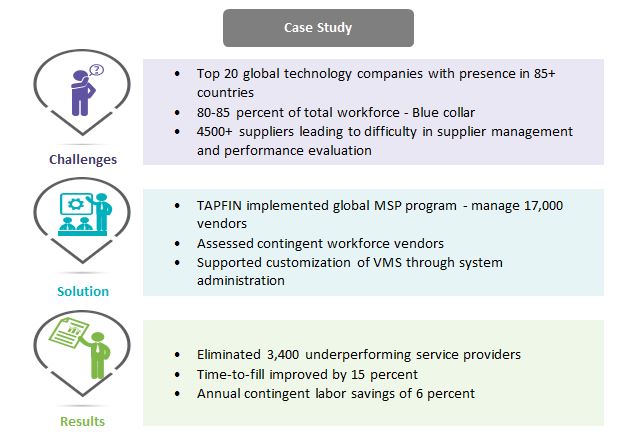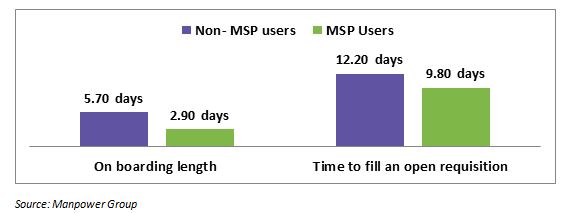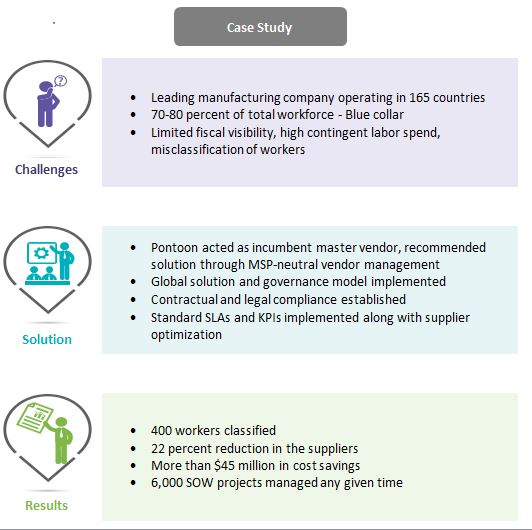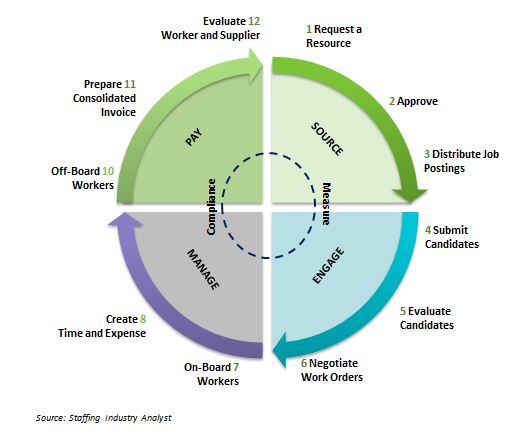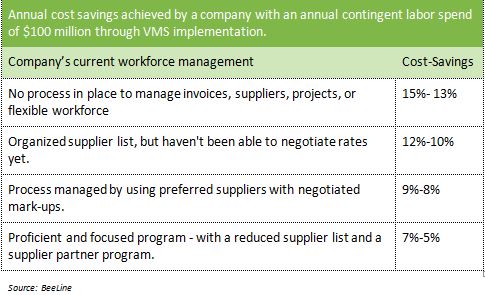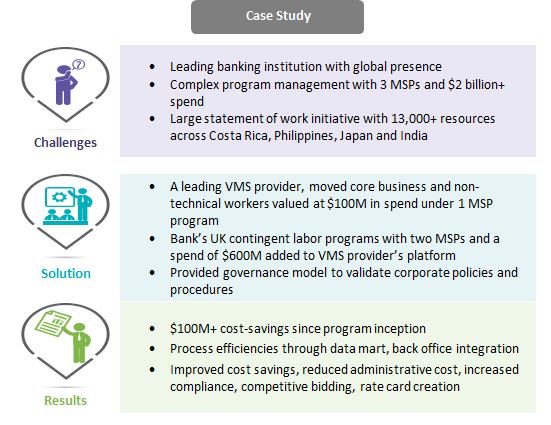
3 secrets of supplier management in staffing

Introduction
Businesses have drastically increased the usage of contingent labor over the past decade. Few large companies estimate that as much as 30 percent of their procurement spend goes towards contingent labor. Presently, around 25-35 percent of an average company’s overall workforce is contingent and by 2017, 45 percent of the global workforce will be contingent.
Contingent labor gives greater flexibility, extends their capabilities and optimises contingent workforce spend.That said, contingent workforce presents its own set of challenges.
Contingent labor is often managed by different category heads and hiring managers using multiple vendors, different approaches, service and price points making it highly challenging.
In such a situation, the whole objective of attaining low cost using contingent workforce vanishes and the companies end up spending higher on the contingent labor.
This whitepaper will focus on providing solutions to streamline and optimize contingent labor management, by adopting best-in-class supplier management strategies. It would discuss key benefits and cost-savings that companies can achieve by implementing the proposed strategies.
The top 3 supplier management startegies recommended and discussed in this white paper are vendor consolidation, managed service provider and vendor mangement system.
Problem Statement and Solutions
One of the burning issues that organisations face today is effective and efficient supplier management. Over time, it is common for organisations to find themselves surrounded by a large number of service providers or suppliers.
Irrespective of the number of suppliers, multi-vendor management is complex, time consuming and expensive. It has been observed that the increase in number of suppliers within an organisation also increases the probability of supplier management getting out of hand leading to operational inefficiencies and higher sourcing costs.
Organizations on an average lose 25 percent to 50 percent of their inherent value (i.e. savings, deferred costs, efficiencies, productivity improvement, etc.) due to poor supplier management.
To efficently manage the supplier base, organisations are advised to follow supplier management stategies which would help them in achieving the right mix of suppliers (In terms of number of supplier engagements, service capabilities, geographic coverage, etc.) and also derive maximum cost-savings.The stategies have been discussed in detail below.
Organisations often face difficulty in deciding the appropriate mix of suppliers and end up engaging with a huge number of suppliers for similar services.One of the main reasons for such multiple engagements is the lack of information-sharing among the regional category managers.
Another reason that results in multiple supplier engagement is the absence of prefered supplier list. In the absence of preferred suppliers, a new service request received by a category manager is opened to multiple suppliers in the market and the supplier with lowest bidding is brought into contract. Category managers of an organisation enter into similar supplier engagements which over time leads to numerous supplier engagements, thereby leading to inconsistency and lack of standardization.
Organizations should assess their current and future contingent workforce needs and develop a strategy to meet future workforce requirement at a cost that provides value to the business. Organisations should shortlist vendors by aligning their capabilities to specifically defined talent needs. They can source contingent workers through vetted and approved vendors that have defined accountabilities for supporting the organization’s risk and cost management practices.
Solution
A good rule to evaluate an organisation’s current supplier engagement situation is the 80-20 rule. In most cases, 20 percent of the suppliers represent 80 percent of the total annual spend. However, if the top 20 percent of the suppliers do not represent 80 percent of the spend, it requires supplier consolidation. On the other hand, supplier consolidation is also required if 20 percent of the suppliers represent more than 80 percent of the total annual spend, as it conveys the presence of multiple low volume suppliers leading to high purchasing cost.
Percentage spend represented by top three suppliers of contingent labor category can also be used to evaluate if there is a requirement of supplier consolidation. Supplier consolidation is required in case 50 percent of the category spend does not go to the top three suppliers. Reducing the number of suppliers in category will increase economies of scale and bring more savings.
Cost Savings
Benefits:
Supplier consolidation increases competition among suppliers and they relish the opportunity to become preferred providers. This can make them gain access to locations and divisions that might have previously been closed to them.
Organisations might feel that reduced supplier base can cause difficulties while handling a flood of requisitions. However, experience has shown that when competitive suppliers are put in preferred supplier role, they are able to commit additional internal resources and meet the demand efficiently.
An MSP is a third party that manages contingent labor suppliers and full time resources dedicated to the particular account.
Typical responsibilities of an MSP include overall program management, reporting and tracking, vendor selection and management, order distribution, and consolidated billing.
MSP solutions are different and better than earlier staffing programs because they include much broader range of labor categories, skill sets, geographies and services designed to include all applicable sourcing models.
MSP Benefits
- Improved workforce quality and fulfilment
- Cost savings through active cost management
- Greater business intelligence
- Improved process and automation
- Increased visibility and business intelligence
- Optimized supply base
- Mitigated risk
- Comprehensive solutions spend management
- Global supply chain management, governance and visibility
Cost-Savings
VMS comes in place to help organisations effectively manage their contingent workforce by facilitating staffing requisitions, interview and hire process, timecards and invoicing.
Typical features of a VMS include order distribution, consolidated billing and significant enhancements in delivering actionable data and reporting capabilities.
Key Benefits
• Total Talent Management – Visibility, alignment, assessment, measurement and productivity across all talent pools, both permanent and contingent.
• Cost Control and Savings –Delivers real-time access to spend and vendor data. Track labor costs to budget, rate and supplier management, invest in SOW capabilities.
• Compliance – Mitigate risk by ensuring compliance requirements are being met across the employee lifecycle.Transactional control points ensure 100 percent contract compliance and successfully meeting procurement’s negotiated terms.
• Efficiency – Automate onboard and off-board processes, centralize vendor management, intuitive user interface.
• Visibility – Drive decision-making and strategy with meaningful analytics, business intelligence and robust reporting.
Cost-Savings
Conclusion
Usage of contingent workforce is high and rising in all the industries across the globe. A successful contingent workforce program can be achieved through a thoughtful supplier management program by incorporating the right mix of best practices, strategies and tools in place.
Supplier consolidation is one such strategy that can be adopted by an organization of any size irrespective of their contingent labor spend that leads to creation of a preferred supplier chain by engaging with the right mix of suppliers. Here, organizations also gain cost-saving opportunities through competitive rates and volume discount.
Engaging with an MSP/VMS is another best-practice that is correlated with the buyer size and annual spend in the past. Earlier, organizations with less than $20 million annualized spend would not opt for an MSP/VMS solution and manage their programs in-house through their procurement or human resource teams.
However, in recent times MSP/VMS service providers are coming up with innovative service models and are able to deliver the benefits offered through these programs within more spend-restricted environments.
The organisations as a first step towards supplier management goal opt for vendor consolidation and create preferred supplier list. Organisations with an employee size of 1K and above then tie up with a Managed Service Provider to manage their preferred supplier base. Combining the transactional power of a VMS with the workforce management expertise of an MSP enables businesses to gain the essential business insights they need to accelerate growth and improve results.
Vendor consolidation, MSP and VMS are the most sought-after tactical and strategic mechanisms behind supplier management strategy. However, the choice of opting any of the mentioned strategies or otherwise would totally depend on the organisation’s current and future contingent workforce management strategy. Organisations should understand and articulate their requirements and priorities before approving any of the strategies to gain real benefits out of their contingent workforce programs.
Related Insights:
View All
Get more stories like this
Subscirbe for more news,updates and insights from Beroe


